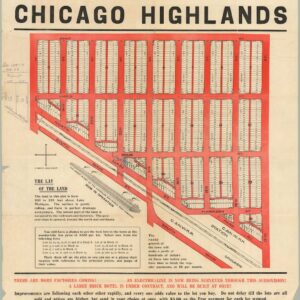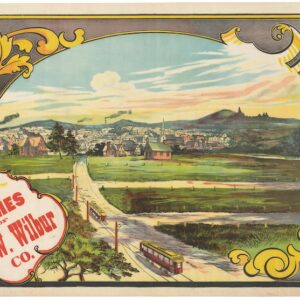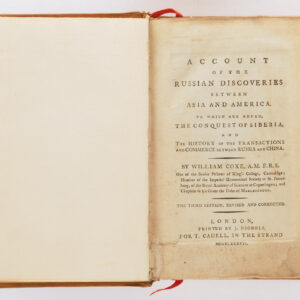A failed scheme to make Jamaica Bay a seaport.
How Jamaica Bay is Being Made into a Great Harbor / Jamaica Bay Harbor / Plan of Dock Comm’r Tomkins.
Out of stock
Description
This curious and scarce sheet was prepared by the real estate developer Howard Estates Development Co. in c. 1912 to promote property in the vicinity of Jamaica Bay in New York City, which was slated to undergo a major development project to turn it into a seaport. However, progress on the project was slow and it was ultimately halted by the entry of the U.S. into World War 1.
The recto contains a bird’s-eye view (drawn by Arthur H. Heiser) that originally appeared in the Brooklyn Daily Eagle in April 1910, presenting Brooklyn and much of Queens, facing westwards towards Manhattan and the Bronx. The view depicts an imagined scene of what Jamaica Bay, in the foreground, will look like once the seaport project was completed. The proposed development of ‘Howard Estates’ is highlighted, while an arc is traced through the city noting real estate prices in different areas, with the implication being that the property value along Jamaica Bay would soon match or exceed that elsewhere in the city.
The recto similarly borrows from a January 1912 illustration in the Brooklyn Daily Eagle that provides another perspective on the proposed harbor plan, this time as discussed by Ports Commissioner Calvin Tomkins, again with Howard Estates highlighted, though this time including a representation of the actual current state of the Bay, as a shallow estuary filled with marshes.
The Jamaica Bay Improvement Plan
The Jamaica Bay Improvement Plan in the early 20th century was a major series of engineering and urban development projects aimed at enhancing the infrastructure, water management, and economic potential of the Jamaica Bay area in New York City, on the border of Brooklyn and Queens. The Army Corps of Engineers had conceived of plans to dredge the Rockaway Inlet as early as 1886, but the plan was not pursued given the remoteness of the area at the time. However, in the following decades, as New York City grew and was consolidated as the five boroughs, demand for increased port facilities seemed to justify such a project. In 1910, the idea of a seaport was revived as part of the wider New York State Canal System, meant to replace the Erie Canal. A pier was built and dredging work began, but proved difficult amid the fickle sand and tides of the Bay; the Long Island Railroad built a station and small spur line in anticipation of the project’s ultimate completion and some businesses and housing began springing up with the same anticipation.
A great deal of progress had been made by 1918, but was suddenly halted as the U.S. entry into the First World War shifted priorities. In the late 1920s, the project was revived and gained political and financial support at the city, state, and federal level, with the LIRR again making plans to built considerable facilities in the area. But New Jersey was deeply opposed to the plan given its own developing port facilities, and the already powerful Robert Moses (at this time New York City Parks Commissioner) disliked the project and had Jamaica Bay designated as a park, effectively killing the port plan.
For its part, Howard Estates never developed as planned either. The glove manufacturer William J. Howard had a goat farm in the area, from which leather was provided for gloves, but realized its potential as a real estate development and formed the Howard Estates Development Co. in 1909. Undertaking his own dredging work, streets were laid out, utilities connected, and a distinct neighborhood formed by the mid-1910s. However, the area did not see true urban development until the post-World War II period, by which time it was known by the less grandiloquent name Howard Beach, while the east and southern coast of the Bay remained mostly as a getaway for city dwellers rather than the industrial facilities seen here. A portion of the Bay at right here was later filled in to create Idlewild Airport, forerunner to today’s John F. Kennedy International Airport (a portion of the western part of the Bay was similarly filled in to create Floyd Bennett Field, long since converted to a park and historic site).
Census
This is an odd work, reprinting two pages (perhaps front pages) from the Brooklyn Daily Eagle from non-consecutive dates. The stamps at top-left and right and the red overprint throughout indicate that these were reprinted as an advertisement for the Howard Estates Development Co. We have been unable to find any other examples of this promotional piece in institutional collections or on the market.
Cartographer(s):
The Brooklyn Daily Eagle, later known simply the Brooklyn Eagle and by other names at various points, was a major local newspaper in Brooklyn, New York from 1841 to 1955. In addition to impressive maps and views published in the paper or as supplements to it, the Eagle also published a well-regarded almanac for several years in the early 20th century.
Condition Description
Small chip along top edge.
References


![[AMERICAN REVOLUTION] Boston, George Washington, Franklin, Philadelphia, Washington, D.C.](https://neatlinemaps.com/wp-content/uploads/2024/05/NL-02090a_thumbnail-300x300.jpg)
